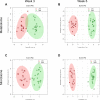Dietary resistant starch preserved through mild extrusion of grain alters fecal microbiome metabolism of dietary macronutrients while increasing immunoglobulin A in the cat
- PMID: 33141838
- PMCID: PMC7608938
- DOI: 10.1371/journal.pone.0241037
Dietary resistant starch preserved through mild extrusion of grain alters fecal microbiome metabolism of dietary macronutrients while increasing immunoglobulin A in the cat
Abstract
Dietary digestion-resistant starch (RS) provides health benefits to the host via gut microbiome-mediated metabolism. The degree to which cats manifest beneficial changes in response to RS intake was examined. Healthy cats (N = 36) were fed identically formulated foods processed under high (n = 17) or low (n = 19) shear extrusion conditions (low and high RS levels [LRS and HRS], respectively). Fecal samples collected after 3 and 6 weeks' feeding were assayed for stool firmness score, short-chain fatty acids, ammonia, and changes to the global metabolome and microbiome; fecal immunoglobulin A (IgA) was analyzed at week 6. Few differences were seen in proximate analyses of the foods; stool firmness scores did not differ. In cats consuming HRS food, concentrations of fecal butyrate and the straight chain:branched chain fatty acid ratio were significantly greater in feces at both weeks 3 and 6, while fecal ammonia was reduced at week 6 relative to feces from LRS-fed cats. Fecal IgA concentrations were significantly higher at week 6 with HRS food. RS consumption altered 47% of the fecal metabolome; RS-derived sugars and metabolites associated with greater gut health, including indoles and polyamines, increased in the cats consuming HRS food relative to those fed the LS food, while endocannabinoid N-acylethanolamines decreased. Consumption of HRS food increased concentrations of the ketone body 3-hydroxybutyrate in feces and elevated concentrations of reduced members of NADH-coupled redox congeners and NADH precursors. At the microbiome genus-level, 21% of operational taxonomic units were significantly different between food types; many involved taxa with known saccharolytic or proteolytic proclivities. Microbiome taxa richness and Shannon and Simpson alpha diversity were significantly higher in the HRS group at both weeks. These data show that feline consumption of grain-derived RS produces potentially beneficial shifts in microbiota-mediated metabolism and increases IgA production.
Conflict of interest statement
The authors have read the journal’s policy and have the following competing interests: MIJ and CW are current employees of Hill’s Pet Nutrition, and DEJ is a former employee of Hill's Pet Nutrition, which provided funding for this study. The authors would like to declare the following patent applications associated with this research: “Pet food composition and method of making pet food composition comprising enhanced levels of resistant starch” (WO2019112562A1). This does not alter our adherence to PLOS ONE policies on sharing data and materials.
Figures


Similar articles
-
Consumption of identically formulated foods extruded under low and high shear force reveals that microbiome redox ratios accompany canine immunoglobulin A production.J Anim Physiol Anim Nutr (Berl). 2020 Sep;104(5):1551-1567. doi: 10.1111/jpn.13419. Epub 2020 Jul 23. J Anim Physiol Anim Nutr (Berl). 2020. PMID: 32705743 Free PMC article.
-
Processing of corn-based dog foods through pelleting, baking and extrusion and their effect on apparent total tract digestibility and colonic health of adult dogs.J Anim Sci. 2024 Jan 3;102:skae067. doi: 10.1093/jas/skae067. J Anim Sci. 2024. PMID: 38553986 Free PMC article.
-
Chronic kidney disease in cats alters response of the plasma metabolome and fecal microbiome to dietary fiber.PLoS One. 2020 Jul 2;15(7):e0235480. doi: 10.1371/journal.pone.0235480. eCollection 2020. PLoS One. 2020. PMID: 32614877 Free PMC article.
-
Conserved and variable responses of the gut microbiome to resistant starch type 2.Nutr Res. 2020 May;77:12-28. doi: 10.1016/j.nutres.2020.02.009. Epub 2020 Feb 22. Nutr Res. 2020. PMID: 32251948 Free PMC article. Review.
-
The mechanisms in the gut microbiota regulation and type 2 diabetes therapeutic activity of resistant starches.Int J Biol Macromol. 2024 Aug;274(Pt 1):133279. doi: 10.1016/j.ijbiomac.2024.133279. Epub 2024 Jun 19. Int J Biol Macromol. 2024. PMID: 38906356 Review.
Cited by
-
Evaluation of corn fermented protein on the fecal microbiome of cats.J Anim Sci. 2024 Jan 3;102:skae268. doi: 10.1093/jas/skae268. J Anim Sci. 2024. PMID: 39276154 Free PMC article.
-
Extrusion Processing Modifications of a Dog Kibble at Large Scale Alter Levels of Starch Available to Animal Enzymatic Digestion.Foods. 2021 Oct 21;10(11):2526. doi: 10.3390/foods10112526. Foods. 2021. PMID: 34828807 Free PMC article.
-
Collaborative Metabolism: Gut Microbes Play a Key Role in Canine and Feline Bile Acid Metabolism.Vet Sci. 2024 Feb 18;11(2):94. doi: 10.3390/vetsci11020094. Vet Sci. 2024. PMID: 38393112 Free PMC article. Review.
-
Gut Metabolome in Companion Animal Nutrition-Linking Diets to Health.Animals (Basel). 2025 Feb 24;15(5):651. doi: 10.3390/ani15050651. Animals (Basel). 2025. PMID: 40075934 Free PMC article. Review.
-
Dietary Betaine Interacts with Very Long Chain n-3 Polyunsaturated Fatty Acids to Influence Fat Metabolism and Circulating Single Carbon Status in the Cat.Animals (Basel). 2022 Oct 19;12(20):2837. doi: 10.3390/ani12202837. Animals (Basel). 2022. PMID: 36290222 Free PMC article.
References
-
- Omosebi MO, Osundahunsi OF, Fagbemi TN. Effect of extrusion on protein quality, antinutritional factors, and digestibility of complementary diet from quality protein maize and soybean protein concentrate. J Food Biochem. 2018;42: e12508.
MeSH terms
Substances
LinkOut - more resources
Full Text Sources
Medical
Miscellaneous

